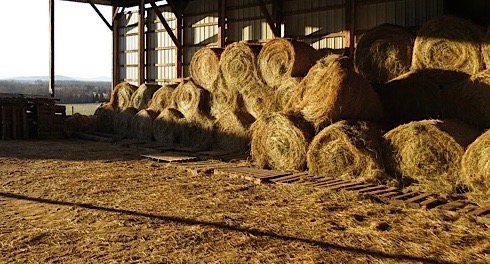Farmcolony is a cattle operation with fields of hay grown and harvested to provide for winter feeding of our livestock. Each year, we mow and bale our own hay and always have a few spoiled bales leftover that cannot be used to feed the animals, usually because of high moisture levels in the bales that allow mold to develop. These unsuitable bales become scrap hay.
“I doubt we have records concerning scrap hay,” Bill explains. “However, I can say that although we try to have only hay that is good for animals, we almost always have some bales that do not meet that standard.”
According to Dieter, “We generate anywhere from 2-20 bales (of scrap hay). No typo on the 20,” Dieter adds. “I can explain how that happened. I know Bill remembers that year.”
Waste Not, Want Not
While scrap hay is not suitable for feeding, it still has other uses on the farm. As Bill points out, the garden is the major benefactor of our poor-quality bales. Often scrap hay is used in the garden as mulch, as a soil amendment, or for composting.
Spoiled hay qualifies as organic matter making it a good material for improving garden soil. Decaying organic matter adds nutrients, improves drainage and increases aeration in the soil, for starters. No small things. A mulch of spoiled hay also suppresses weeds, keeps the soil cool and moist, holds veggies off the ground where they are prone to rot, keeps our produce cleaner and fresher by reducing soil backsplash from falling rain, discourages the spread of diseases like blight from infecting our plants…and the list goes on.
Spoiled hay is also a natural for adding to the compost bin. Heaping mounds of hay layered with green matter, such as grass clippings, fruit and vegetable peels and cores, and other fresh kitchen wastes, start the composting process. Moistening the pile and turning it every few days keeps the process going, aiming for a 1:1 ratio of dry to wet ingredients. Or when you have large amounts of dry material, like we do with our scrap hay, sprinkling a handful of 10-10-10 fertilizer over the pile before watering provides the nitrogen needed to compost it effectively.
Not all that Glitters is Gold
But be warned. Hay can be full of grass seeds that can sprout into weeds. In the Farmcolony garden, we’ve had problems with weeds after using hay as a mulch, big problems. (Dear God, make me as tough as that grass!)
There is hope, however. According to one commenter on “Ideas for Best Use of Spoiled Hay, Leaf Mould in Small Garden,” (https://permies.com/t/15013/ideas-spoiled-hay-leaf-mould) “You can look at the hay and tell if it’s saturated with seed heads or if there are just a few here and there.”
Another commenter advises, “Just remember, as Ruth Stout said– if you have weeds, your mulch isn’t thick enough. If you always remember this, you’ll do O.K.” Ruth Stout is an American author best known for her “no-work” gardening books and techniques.
Be careful when working with scrap hay, though. While good for vegetables, the spores of mold can cause severe respiratory problems if you inhale them. It’s important to wear a good filtering mask (not a bandana) when handling spoiled hay.
More Uses for Scrap Hay
Here are some other possible uses for spoiled hay around the farm:
- Bedding for the horses, goats, and other animals on the farm, and stuffing for hen boxes. Chickens LOVE to scratch, roll and play in fresh hay.
- Throwing it on the manure pile. (A subject for another day.)
- Preventing soil erosion.
- Building a compost pile.
- Filling in bald spots on your lawn.
- Spoiled hay can also be used as a fertilizer for a lawn. Tear the moldy hay up into chunks (Don’t forget to wear a mask to protect your lungs from unhealthy spores), sprinkle the chunks onto the lawn before mowing, then mow it. The hay will add nutrients and organic matter and retain moisture so you won’t need to water your lawn as often.
Another Farm Perk
According to Dieter, once the farm’s needs are covered, scrap hay on the farm is available to us on a first come, first served basis. This year we have probably 4-5 bales of waste hay. Anyone who would like to get some scrap hay for their personal use should contact Angel or Dieter. They know how much scrap hay is available and where the spoiled bales are located.
Or perhaps you would like to be a “scrap hay vulture,” Bill suggests. Scrap hay vultures clean up hay left in the fields by feeding rings and the hay feeding trailer or on the barn floor. (Never in the hay fields, Dieter adds.) But, Bill warns, cleaning up hay left in the fields is hard work.
You can also rescue scrap hay from the burn pile. As Dieter notes, “We have also taken it to the burn pile, particularly that which is left in the hay wagon and is rotting due to the snow and rain.”
The amount of scrap hay available on the farm varies greatly from year to year. The leftovers are available to members of our farming community on a first come, first served basis (one more perk of living on the farm), but only after farm needs are met and as directed by Dieter and Angel.
If you would like a more detailed description of mold growth and hay quality, this link describes it in more detail. https://fyi.extension.wisc.edu/forage/understanding-and-reducing-mold-growth-in-hay/
Those wanting more information on composting spoiled hay can check out this link for a more in-depth look. http://agriculture.vic.gov.au/agriculture/farm-management/recycling-and-waste-management/composting-spoiled-hay
Photo of hay bales courtesy of Margaret Prior


